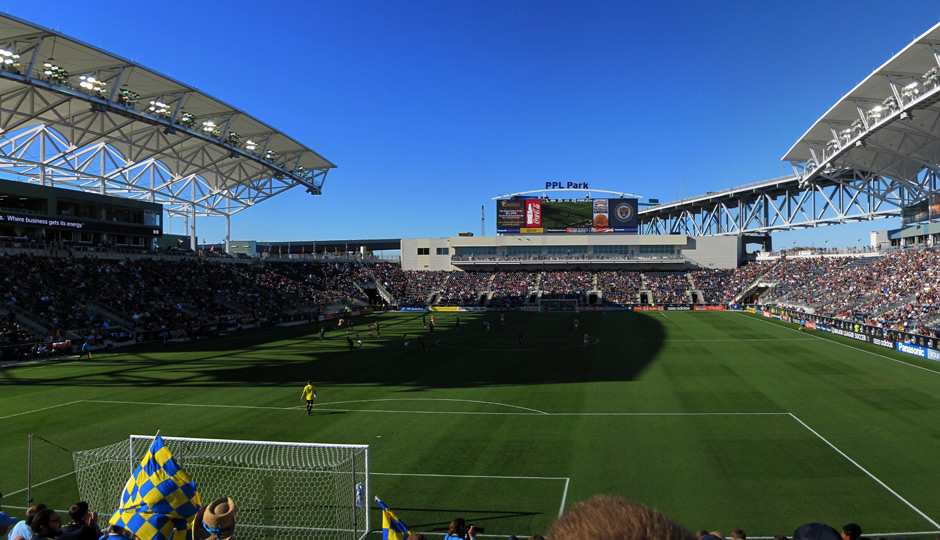Next Time the Eagles Want a New Stadium, They May Have to Pay for It Themselves

Photo | Something Original
Taxpayers and local governments have been subsidizing pro-sports stadiums since the Reagan years, and as the decades pass, the subsidies have only gotten bigger. During the 1990s, construction of new sports stadiums cost the public an average of $142 million per facility. By 2010, that number had increased 70 percent to $241 million. The luxe new Yankee Stadium was built with $322 million in public subsidies. Philadelphia’s Lincoln Financial Field and Citizens Bank Park were not exceptional ($256 and $229 million in public costs, respectively), both funded by a 50-50 public and private split.
Economists and social scientists are scornful of these enormous subsidies. Plentiful research has shown that stadiums rarely produce the anticipated return on investment for the surrounding area, in terms of jobs and ancillary profits (in restaurants, hospitality, etc.). As Pacific Standard wrote in 2013:
Economists have long known stadiums to be poor public investments. Most of the jobs created by stadium-building projects are either temporary, low-paying, or out-of-state contracting jobs—none of which contribute greatly to the local economy … Most fans do not spend additional money as a result of a new stadium; they re-direct money they would have spent elsewhere on movies, dining, bowling, tarot-card reading, or other businesses.
And yet local governments can’t seem to help themselves. In 2013, the Atlanta Braves decided to build a new stadium in the suburbs that will use nearly $400 million in public money and cost the county $8.6 million in foregone property taxes. Wisconsin Governor Scott Walker has proposed building a new Milwaukee Bucks stadium with $220 million in state bonds.
President Obama is now calling foul.
In the latest presidential budget proposal, for fiscal year 2016, there’s an item to “repeal tax-exempt bond financing of professional sports facilities.” That would scuttle all future plans like those of the Braves or Bucks—relying on public money. The Office of Management and Budget estimates that the sports-stadium item would return $542 million to the U.S. Treasury over the next 10 years. Plus, it would restore the intended purpose of tax-exempt bonds—which are traditionally a means of funding local infrastructure improvements—instead of using them to fund state-of-the-art stadium gimmicks like a 25,000-square foot Jumbotron at Cowboys Stadium. Of course, team owners are bound to be furious.
If Obama needs a poster child for the budget item, he need look no further than PPL Park. Before it opened in 2010, Governor Ed Rendell proclaimed the Major League Soccer stadium would “change the face of Chester forever.” Quite simply, it hasn’t. Adjacent to the Union’s home field remain undeveloped, vacant lots. Even though attendance has been relatively successful at PPL Park — the 18,500-seat stadium averaged 17,631 fans per game —most fans drive home to Philadelphia and the ‘burbs afterwards. Few of the ancillary effects of having a sports stadium centrally located along the waterfront have been realized.
A majority of PPL Park’s $122 million in construction costs was paid for with public funding, including $47 million from the state, $30 million from Chester County and $10 from the Delaware River Port Authority. On top of that, the stadium received significant tax breaks from the state (those ended in 2013) as a Keystone Opportunity Zone. Before he was Chester’s mayor, John Linder was a professor of social sciences who questioned why the city should “bring soccer to a basketball town.” As Mayor, he’s had to plead with the Union to cough up overdue payments-in-lieu-of-taxes, simply to make up a fraction of the public money used to build the Union’s house.
All of that development money expended in Chester could’ve gone to small-business grants or neighborhood revitalization—or the school system, in the case of the state money—rather than PPL Park. The same could be said for stadiums nationwide built over the last 30 years, which have cost taxpayers $4 billion in lost revenue off federal tax-exempt bonds alone (plus much, much more in direct local and state subsidies) If a federal budget passes with the item included (it should be noted that Congressional Republicans, like Senator John McCain, have called this iteration of the budget “dead on arrival”), it’ll become considerably more expensive to build stadiums, both for the teams and the local governments that have subsidized them.
Will that be enough to get cities and counties out of the stadium-building business? If Obama’s budget passes, we’ll soon find out.